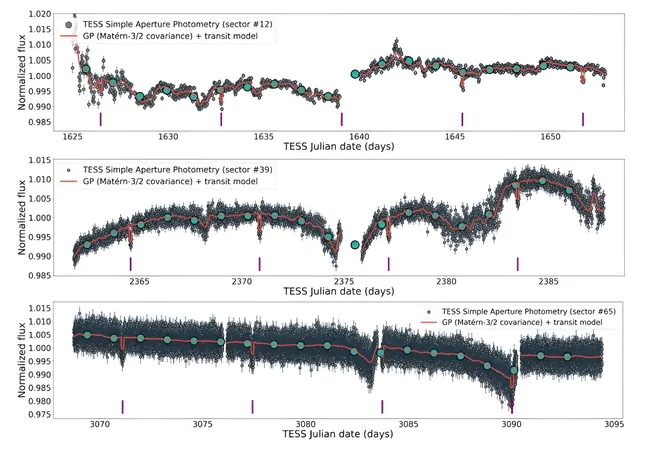
Astronomers Unveil New Super-Neptune Exoplanet: Meet TOI-5005 b!
2024-10-02
Introduction
In an exciting discovery that has captured the attention of the astronomical community, an international team of astronomers has announced the finding of a new super-Neptune exoplanet, designated TOI-5005 b. This alien giant stands out for being approximately six times larger and over 30 times more massive than Earth, and its discovery was detailed in a paper published on September 26 on the pre-print server arXiv.
Discovery Details
NASA's Transiting Exoplanets Survey Satellite (TESS) has been on the frontline of exoplanet exploration, meticulously surveying nearly 200,000 of the brightest stars in our solar neighborhood to hunt for transiting exoplanets. With its current tally, TESS has identified over 7,200 candidate exoplanets, known as TESS Objects of Interest (TOI), with 557 of these having been confirmed as actual exoplanets.
The breakthrough with TOI-5005 b came from a research team led by Amadeo Castro-González at the Astrobiology Center in Madrid, Spain. They detected a notable transit signal from the light curve of TOI-5005, a moderately bright star of the G2V spectral type located about 685 light-years away. Follow-up observations utilizing ground-based facilities confirmed the planetary nature of this signal.
Planet Characteristics
In their research, the astronomers leveraged data from TESS, HARPS, PEST, and TRAPPIST-South to validate the characteristics of TOI-5005 b. This new planet boasts a radius of 6.25 times that of Earth, with a mass approximately 32.7 times greater than our home planet, resulting in a low density of about 0.74 g/cm³. TOI-5005 b completes an orbit around its host star every 6.31 days, at a distance of around 0.066 astronomical units (AU), accompanied by an estimated equilibrium temperature of 1,040 K.
Planet Structure
Delving deeper into the planet's structure, the astronomers estimated its core mass fraction to be around 0.74 while the envelope metal mass fraction stood at 0.08. Altogether, the overall metal mass fraction of TOI-5005 b was calculated at 0.76, slightly lower than that of Uranus and Neptune. These findings suggest that the formation of TOI-5005 b likely resulted from core accretion processes.
Unique Classification
Significantly, TOI-5005 b is classified as a super-Neptune that resides in the “Neptunian savanna,” a region characterized by the scarcity of Neptune-like exoplanets on shorter periods, in contrast to their modest occurrence at greater distances from their stars. This region is separated by a newly identified density ridge of Neptunes that typically orbit in the range of 3 to 5 days.
Notably, TOI-5005 b joins a rare category of low-density Neptunes, diverging from those in the density ridge, which often exhibit denser structures above 1.0 g/cm³. This finding adds valuable diversity to our understanding of exoplanet compositions and formations.
Future Observations
The researchers have pointed out the significance of the brightness of TOI-5005, identifying this planetary system as a promising target for future observations aimed at unraveling its atmospheric properties and orbital dynamics.
Conclusion
This exciting revelation serves as a reminder of the vast and intricate universe we inhabit, providing tantalizing clues that could lead to groundbreaking discoveries about the nature of planets beyond our solar system. Stay tuned for more astronomical wonders!









 Brasil (PT)
Brasil (PT)
 Canada (EN)
Canada (EN)
 Chile (ES)
Chile (ES)
 España (ES)
España (ES)
 France (FR)
France (FR)
 Hong Kong (EN)
Hong Kong (EN)
 Italia (IT)
Italia (IT)
 日本 (JA)
日本 (JA)
 Magyarország (HU)
Magyarország (HU)
 Norge (NO)
Norge (NO)
 Polska (PL)
Polska (PL)
 Schweiz (DE)
Schweiz (DE)
 Singapore (EN)
Singapore (EN)
 Sverige (SV)
Sverige (SV)
 Suomi (FI)
Suomi (FI)
 Türkiye (TR)
Türkiye (TR)